Unit 4 Task 4: Reflective Essay on Health and Social Care Values
VerifiedAdded on 2021/06/14
|7
|1678
|77
Essay
AI Summary
This reflective essay, titled "Unit 4 Task 4," examines the student's strengths and weaknesses in the context of health and social care, focusing on the core values of human dignity, equality, and compassion. The essay discusses the importance of these values in professional practice and explores the student's commitment to social justice and democracy. The student identifies strengths such as punctuality and an open mind, while also acknowledging weaknesses in interpersonal communication skills and cultural competence. The essay further analyzes the significance of teamwork, the barriers to effective collaboration, and the role of communication and goal-setting within a team. It references Belbin's and Tuckman's theories of teamwork, and it concludes by emphasizing the importance of clear role understanding, measurable goals, and respect for cultural and linguistic diversity in professional practice. References from various authors are also included.

Running head: UNIT 4
Task 4
Name of the Student
Name of the University
Author Note
Task 4
Name of the Student
Name of the University
Author Note
Paraphrase This Document
Need a fresh take? Get an instant paraphrase of this document with our AI Paraphraser
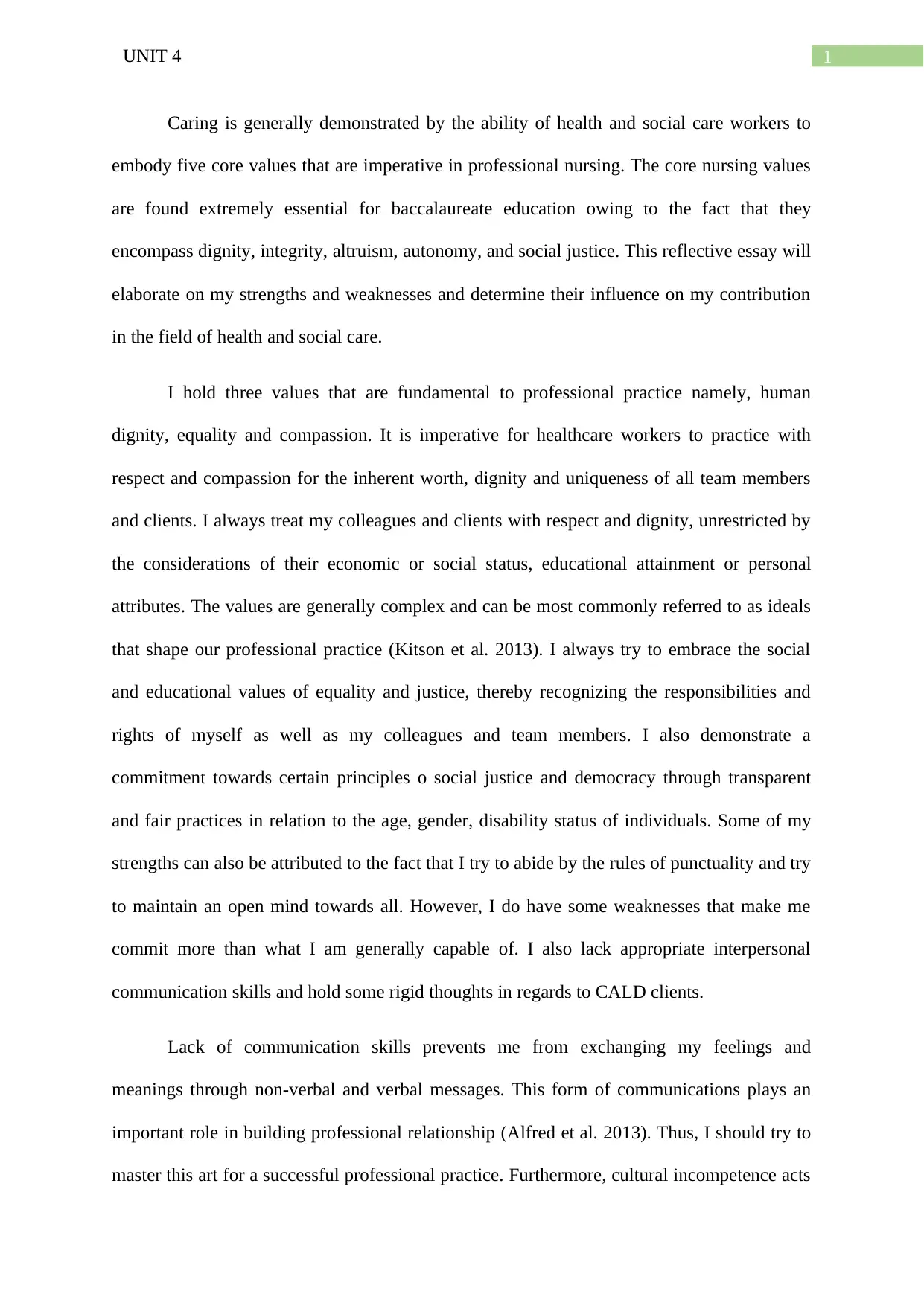
1UNIT 4
Caring is generally demonstrated by the ability of health and social care workers to
embody five core values that are imperative in professional nursing. The core nursing values
are found extremely essential for baccalaureate education owing to the fact that they
encompass dignity, integrity, altruism, autonomy, and social justice. This reflective essay will
elaborate on my strengths and weaknesses and determine their influence on my contribution
in the field of health and social care.
I hold three values that are fundamental to professional practice namely, human
dignity, equality and compassion. It is imperative for healthcare workers to practice with
respect and compassion for the inherent worth, dignity and uniqueness of all team members
and clients. I always treat my colleagues and clients with respect and dignity, unrestricted by
the considerations of their economic or social status, educational attainment or personal
attributes. The values are generally complex and can be most commonly referred to as ideals
that shape our professional practice (Kitson et al. 2013). I always try to embrace the social
and educational values of equality and justice, thereby recognizing the responsibilities and
rights of myself as well as my colleagues and team members. I also demonstrate a
commitment towards certain principles o social justice and democracy through transparent
and fair practices in relation to the age, gender, disability status of individuals. Some of my
strengths can also be attributed to the fact that I try to abide by the rules of punctuality and try
to maintain an open mind towards all. However, I do have some weaknesses that make me
commit more than what I am generally capable of. I also lack appropriate interpersonal
communication skills and hold some rigid thoughts in regards to CALD clients.
Lack of communication skills prevents me from exchanging my feelings and
meanings through non-verbal and verbal messages. This form of communications plays an
important role in building professional relationship (Alfred et al. 2013). Thus, I should try to
master this art for a successful professional practice. Furthermore, cultural incompetence acts
Caring is generally demonstrated by the ability of health and social care workers to
embody five core values that are imperative in professional nursing. The core nursing values
are found extremely essential for baccalaureate education owing to the fact that they
encompass dignity, integrity, altruism, autonomy, and social justice. This reflective essay will
elaborate on my strengths and weaknesses and determine their influence on my contribution
in the field of health and social care.
I hold three values that are fundamental to professional practice namely, human
dignity, equality and compassion. It is imperative for healthcare workers to practice with
respect and compassion for the inherent worth, dignity and uniqueness of all team members
and clients. I always treat my colleagues and clients with respect and dignity, unrestricted by
the considerations of their economic or social status, educational attainment or personal
attributes. The values are generally complex and can be most commonly referred to as ideals
that shape our professional practice (Kitson et al. 2013). I always try to embrace the social
and educational values of equality and justice, thereby recognizing the responsibilities and
rights of myself as well as my colleagues and team members. I also demonstrate a
commitment towards certain principles o social justice and democracy through transparent
and fair practices in relation to the age, gender, disability status of individuals. Some of my
strengths can also be attributed to the fact that I try to abide by the rules of punctuality and try
to maintain an open mind towards all. However, I do have some weaknesses that make me
commit more than what I am generally capable of. I also lack appropriate interpersonal
communication skills and hold some rigid thoughts in regards to CALD clients.
Lack of communication skills prevents me from exchanging my feelings and
meanings through non-verbal and verbal messages. This form of communications plays an
important role in building professional relationship (Alfred et al. 2013). Thus, I should try to
master this art for a successful professional practice. Furthermore, cultural incompetence acts
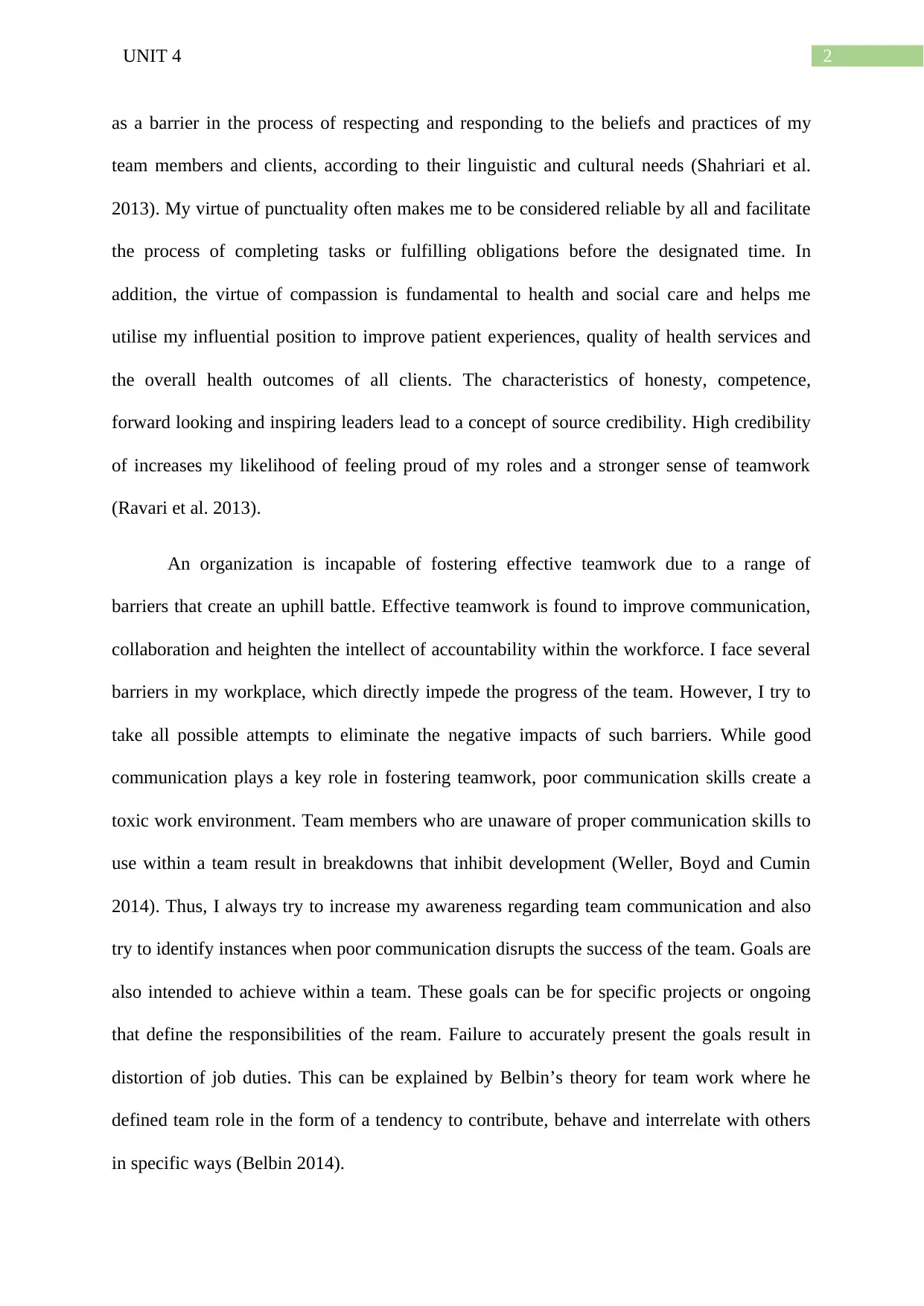
2UNIT 4
as a barrier in the process of respecting and responding to the beliefs and practices of my
team members and clients, according to their linguistic and cultural needs (Shahriari et al.
2013). My virtue of punctuality often makes me to be considered reliable by all and facilitate
the process of completing tasks or fulfilling obligations before the designated time. In
addition, the virtue of compassion is fundamental to health and social care and helps me
utilise my influential position to improve patient experiences, quality of health services and
the overall health outcomes of all clients. The characteristics of honesty, competence,
forward looking and inspiring leaders lead to a concept of source credibility. High credibility
of increases my likelihood of feeling proud of my roles and a stronger sense of teamwork
(Ravari et al. 2013).
An organization is incapable of fostering effective teamwork due to a range of
barriers that create an uphill battle. Effective teamwork is found to improve communication,
collaboration and heighten the intellect of accountability within the workforce. I face several
barriers in my workplace, which directly impede the progress of the team. However, I try to
take all possible attempts to eliminate the negative impacts of such barriers. While good
communication plays a key role in fostering teamwork, poor communication skills create a
toxic work environment. Team members who are unaware of proper communication skills to
use within a team result in breakdowns that inhibit development (Weller, Boyd and Cumin
2014). Thus, I always try to increase my awareness regarding team communication and also
try to identify instances when poor communication disrupts the success of the team. Goals are
also intended to achieve within a team. These goals can be for specific projects or ongoing
that define the responsibilities of the ream. Failure to accurately present the goals result in
distortion of job duties. This can be explained by Belbin’s theory for team work where he
defined team role in the form of a tendency to contribute, behave and interrelate with others
in specific ways (Belbin 2014).
as a barrier in the process of respecting and responding to the beliefs and practices of my
team members and clients, according to their linguistic and cultural needs (Shahriari et al.
2013). My virtue of punctuality often makes me to be considered reliable by all and facilitate
the process of completing tasks or fulfilling obligations before the designated time. In
addition, the virtue of compassion is fundamental to health and social care and helps me
utilise my influential position to improve patient experiences, quality of health services and
the overall health outcomes of all clients. The characteristics of honesty, competence,
forward looking and inspiring leaders lead to a concept of source credibility. High credibility
of increases my likelihood of feeling proud of my roles and a stronger sense of teamwork
(Ravari et al. 2013).
An organization is incapable of fostering effective teamwork due to a range of
barriers that create an uphill battle. Effective teamwork is found to improve communication,
collaboration and heighten the intellect of accountability within the workforce. I face several
barriers in my workplace, which directly impede the progress of the team. However, I try to
take all possible attempts to eliminate the negative impacts of such barriers. While good
communication plays a key role in fostering teamwork, poor communication skills create a
toxic work environment. Team members who are unaware of proper communication skills to
use within a team result in breakdowns that inhibit development (Weller, Boyd and Cumin
2014). Thus, I always try to increase my awareness regarding team communication and also
try to identify instances when poor communication disrupts the success of the team. Goals are
also intended to achieve within a team. These goals can be for specific projects or ongoing
that define the responsibilities of the ream. Failure to accurately present the goals result in
distortion of job duties. This can be explained by Belbin’s theory for team work where he
defined team role in the form of a tendency to contribute, behave and interrelate with others
in specific ways (Belbin 2014).
⊘ This is a preview!⊘
Do you want full access?
Subscribe today to unlock all pages.

Trusted by 1+ million students worldwide
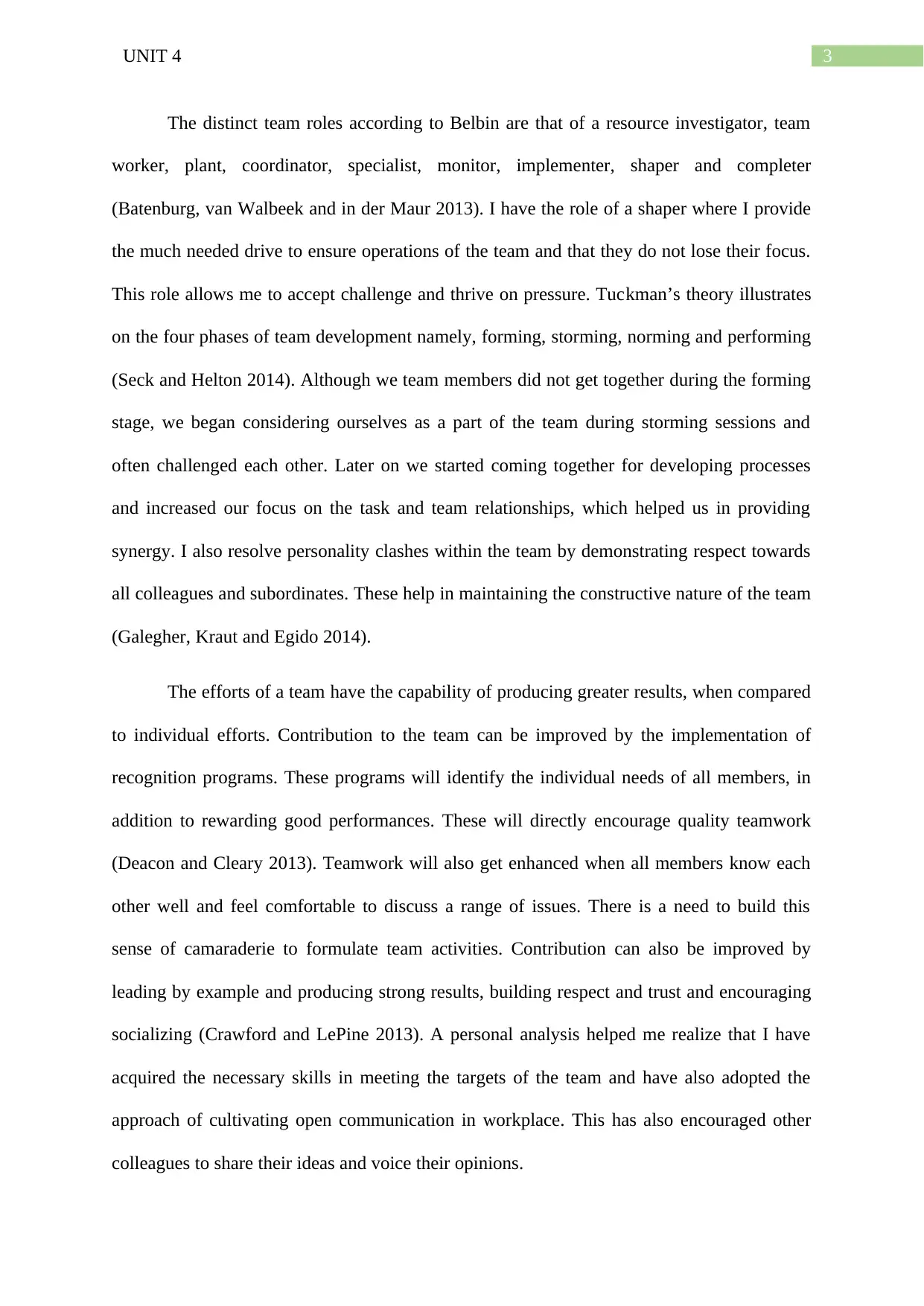
3UNIT 4
The distinct team roles according to Belbin are that of a resource investigator, team
worker, plant, coordinator, specialist, monitor, implementer, shaper and completer
(Batenburg, van Walbeek and in der Maur 2013). I have the role of a shaper where I provide
the much needed drive to ensure operations of the team and that they do not lose their focus.
This role allows me to accept challenge and thrive on pressure. Tuckman’s theory illustrates
on the four phases of team development namely, forming, storming, norming and performing
(Seck and Helton 2014). Although we team members did not get together during the forming
stage, we began considering ourselves as a part of the team during storming sessions and
often challenged each other. Later on we started coming together for developing processes
and increased our focus on the task and team relationships, which helped us in providing
synergy. I also resolve personality clashes within the team by demonstrating respect towards
all colleagues and subordinates. These help in maintaining the constructive nature of the team
(Galegher, Kraut and Egido 2014).
The efforts of a team have the capability of producing greater results, when compared
to individual efforts. Contribution to the team can be improved by the implementation of
recognition programs. These programs will identify the individual needs of all members, in
addition to rewarding good performances. These will directly encourage quality teamwork
(Deacon and Cleary 2013). Teamwork will also get enhanced when all members know each
other well and feel comfortable to discuss a range of issues. There is a need to build this
sense of camaraderie to formulate team activities. Contribution can also be improved by
leading by example and producing strong results, building respect and trust and encouraging
socializing (Crawford and LePine 2013). A personal analysis helped me realize that I have
acquired the necessary skills in meeting the targets of the team and have also adopted the
approach of cultivating open communication in workplace. This has also encouraged other
colleagues to share their ideas and voice their opinions.
The distinct team roles according to Belbin are that of a resource investigator, team
worker, plant, coordinator, specialist, monitor, implementer, shaper and completer
(Batenburg, van Walbeek and in der Maur 2013). I have the role of a shaper where I provide
the much needed drive to ensure operations of the team and that they do not lose their focus.
This role allows me to accept challenge and thrive on pressure. Tuckman’s theory illustrates
on the four phases of team development namely, forming, storming, norming and performing
(Seck and Helton 2014). Although we team members did not get together during the forming
stage, we began considering ourselves as a part of the team during storming sessions and
often challenged each other. Later on we started coming together for developing processes
and increased our focus on the task and team relationships, which helped us in providing
synergy. I also resolve personality clashes within the team by demonstrating respect towards
all colleagues and subordinates. These help in maintaining the constructive nature of the team
(Galegher, Kraut and Egido 2014).
The efforts of a team have the capability of producing greater results, when compared
to individual efforts. Contribution to the team can be improved by the implementation of
recognition programs. These programs will identify the individual needs of all members, in
addition to rewarding good performances. These will directly encourage quality teamwork
(Deacon and Cleary 2013). Teamwork will also get enhanced when all members know each
other well and feel comfortable to discuss a range of issues. There is a need to build this
sense of camaraderie to formulate team activities. Contribution can also be improved by
leading by example and producing strong results, building respect and trust and encouraging
socializing (Crawford and LePine 2013). A personal analysis helped me realize that I have
acquired the necessary skills in meeting the targets of the team and have also adopted the
approach of cultivating open communication in workplace. This has also encouraged other
colleagues to share their ideas and voice their opinions.
Paraphrase This Document
Need a fresh take? Get an instant paraphrase of this document with our AI Paraphraser
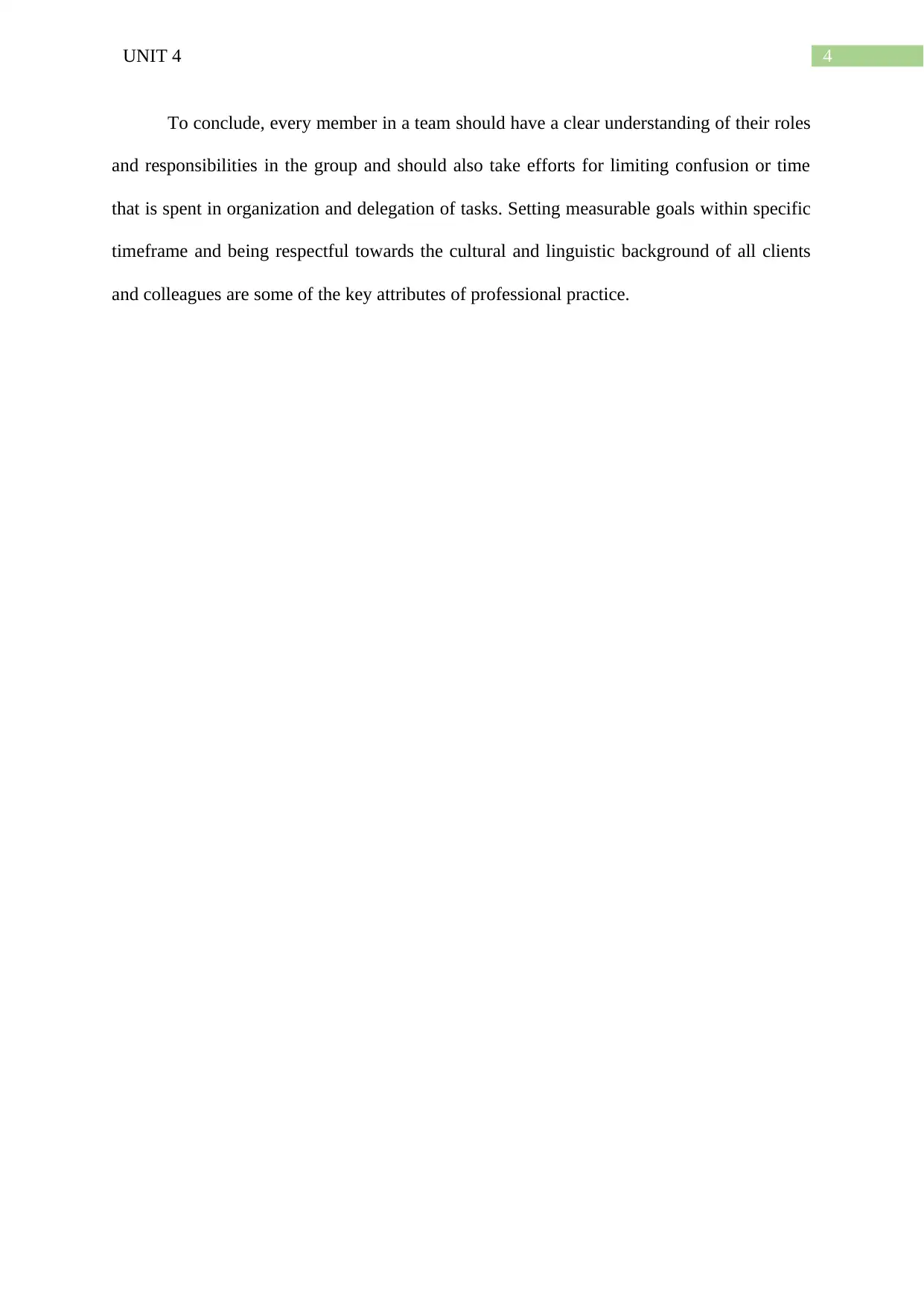
4UNIT 4
To conclude, every member in a team should have a clear understanding of their roles
and responsibilities in the group and should also take efforts for limiting confusion or time
that is spent in organization and delegation of tasks. Setting measurable goals within specific
timeframe and being respectful towards the cultural and linguistic background of all clients
and colleagues are some of the key attributes of professional practice.
To conclude, every member in a team should have a clear understanding of their roles
and responsibilities in the group and should also take efforts for limiting confusion or time
that is spent in organization and delegation of tasks. Setting measurable goals within specific
timeframe and being respectful towards the cultural and linguistic background of all clients
and colleagues are some of the key attributes of professional practice.
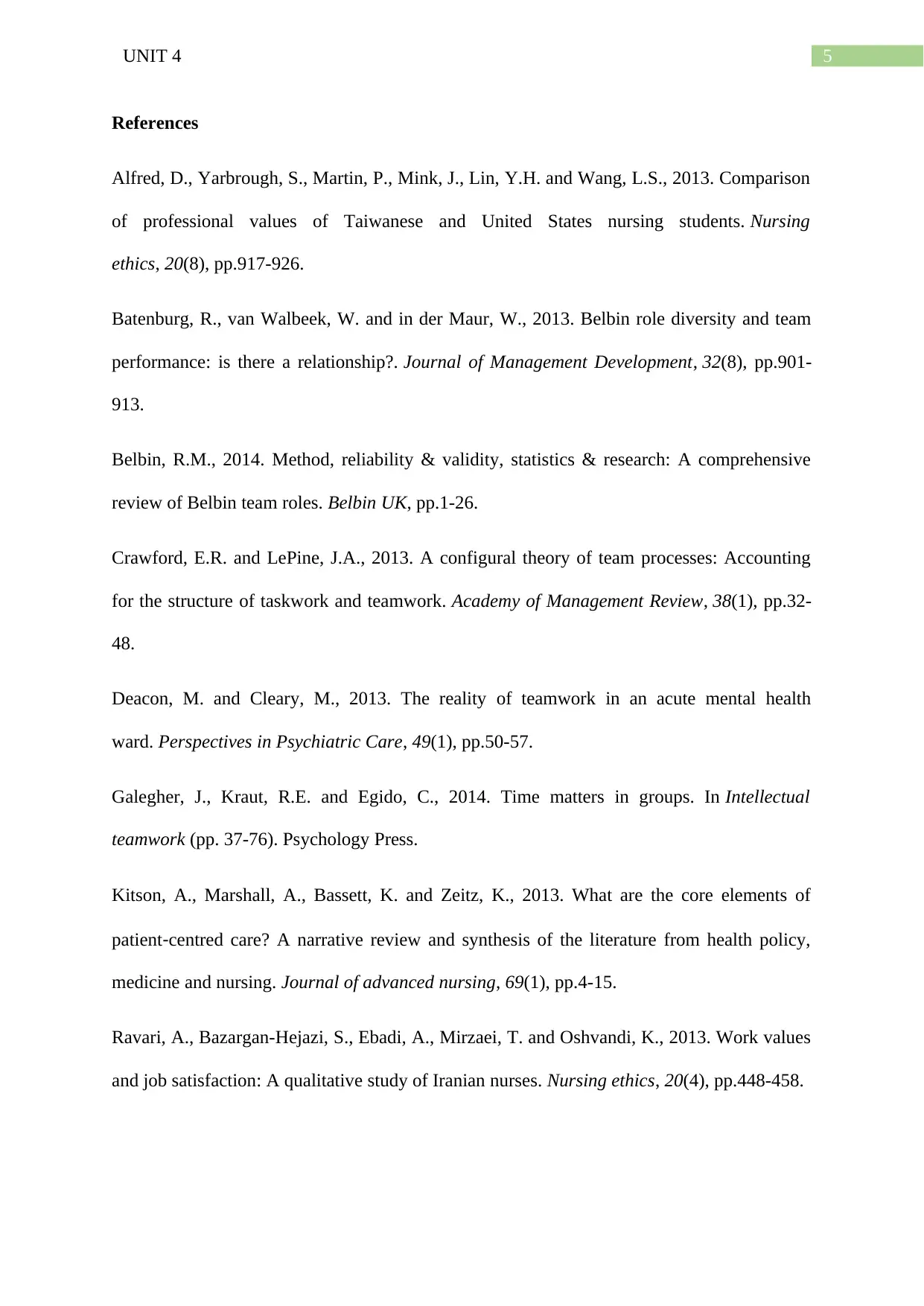
5UNIT 4
References
Alfred, D., Yarbrough, S., Martin, P., Mink, J., Lin, Y.H. and Wang, L.S., 2013. Comparison
of professional values of Taiwanese and United States nursing students. Nursing
ethics, 20(8), pp.917-926.
Batenburg, R., van Walbeek, W. and in der Maur, W., 2013. Belbin role diversity and team
performance: is there a relationship?. Journal of Management Development, 32(8), pp.901-
913.
Belbin, R.M., 2014. Method, reliability & validity, statistics & research: A comprehensive
review of Belbin team roles. Belbin UK, pp.1-26.
Crawford, E.R. and LePine, J.A., 2013. A configural theory of team processes: Accounting
for the structure of taskwork and teamwork. Academy of Management Review, 38(1), pp.32-
48.
Deacon, M. and Cleary, M., 2013. The reality of teamwork in an acute mental health
ward. Perspectives in Psychiatric Care, 49(1), pp.50-57.
Galegher, J., Kraut, R.E. and Egido, C., 2014. Time matters in groups. In Intellectual
teamwork (pp. 37-76). Psychology Press.
Kitson, A., Marshall, A., Bassett, K. and Zeitz, K., 2013. What are the core elements of
patient‐centred care? A narrative review and synthesis of the literature from health policy,
medicine and nursing. Journal of advanced nursing, 69(1), pp.4-15.
Ravari, A., Bazargan-Hejazi, S., Ebadi, A., Mirzaei, T. and Oshvandi, K., 2013. Work values
and job satisfaction: A qualitative study of Iranian nurses. Nursing ethics, 20(4), pp.448-458.
References
Alfred, D., Yarbrough, S., Martin, P., Mink, J., Lin, Y.H. and Wang, L.S., 2013. Comparison
of professional values of Taiwanese and United States nursing students. Nursing
ethics, 20(8), pp.917-926.
Batenburg, R., van Walbeek, W. and in der Maur, W., 2013. Belbin role diversity and team
performance: is there a relationship?. Journal of Management Development, 32(8), pp.901-
913.
Belbin, R.M., 2014. Method, reliability & validity, statistics & research: A comprehensive
review of Belbin team roles. Belbin UK, pp.1-26.
Crawford, E.R. and LePine, J.A., 2013. A configural theory of team processes: Accounting
for the structure of taskwork and teamwork. Academy of Management Review, 38(1), pp.32-
48.
Deacon, M. and Cleary, M., 2013. The reality of teamwork in an acute mental health
ward. Perspectives in Psychiatric Care, 49(1), pp.50-57.
Galegher, J., Kraut, R.E. and Egido, C., 2014. Time matters in groups. In Intellectual
teamwork (pp. 37-76). Psychology Press.
Kitson, A., Marshall, A., Bassett, K. and Zeitz, K., 2013. What are the core elements of
patient‐centred care? A narrative review and synthesis of the literature from health policy,
medicine and nursing. Journal of advanced nursing, 69(1), pp.4-15.
Ravari, A., Bazargan-Hejazi, S., Ebadi, A., Mirzaei, T. and Oshvandi, K., 2013. Work values
and job satisfaction: A qualitative study of Iranian nurses. Nursing ethics, 20(4), pp.448-458.
⊘ This is a preview!⊘
Do you want full access?
Subscribe today to unlock all pages.

Trusted by 1+ million students worldwide
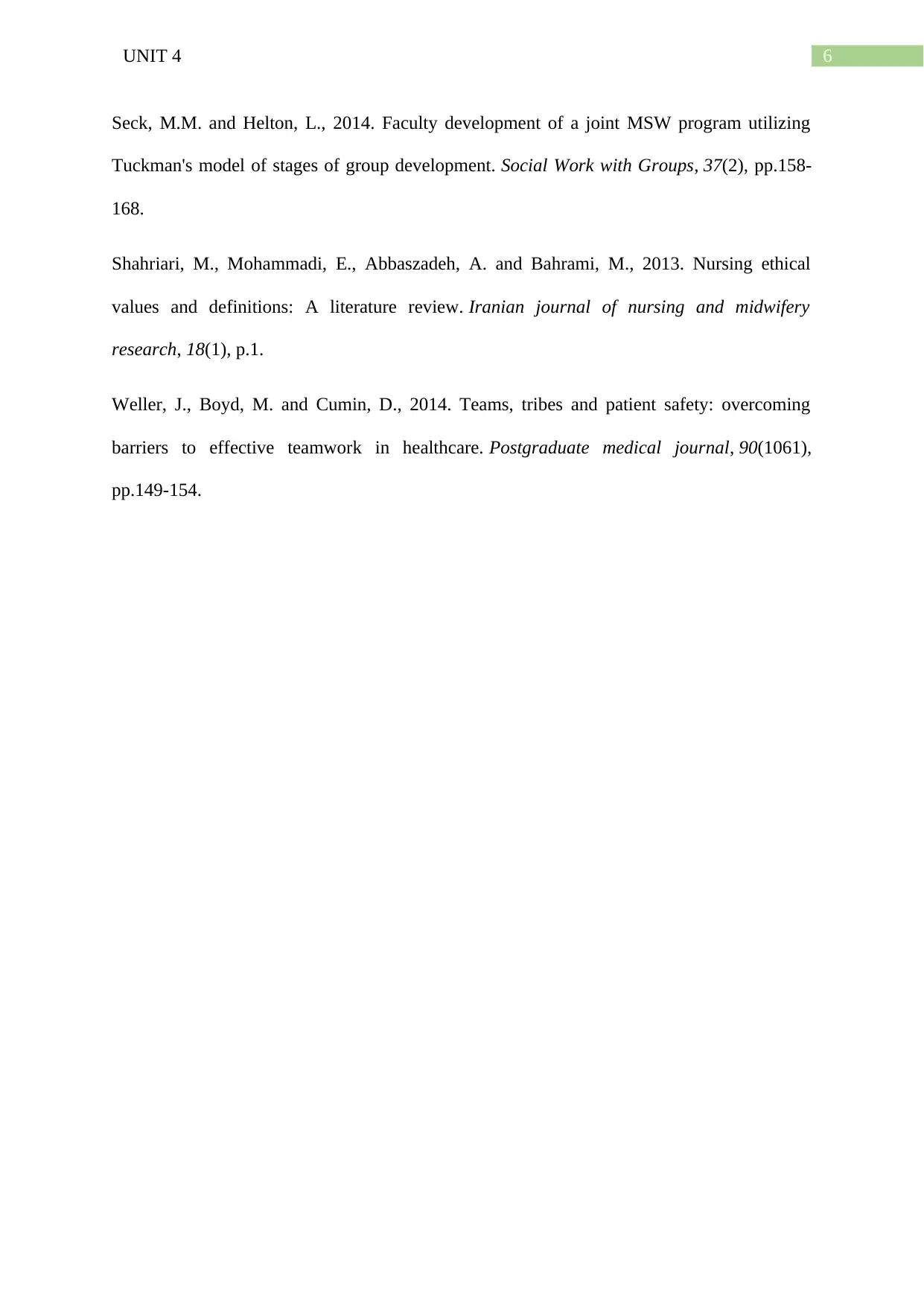
6UNIT 4
Seck, M.M. and Helton, L., 2014. Faculty development of a joint MSW program utilizing
Tuckman's model of stages of group development. Social Work with Groups, 37(2), pp.158-
168.
Shahriari, M., Mohammadi, E., Abbaszadeh, A. and Bahrami, M., 2013. Nursing ethical
values and definitions: A literature review. Iranian journal of nursing and midwifery
research, 18(1), p.1.
Weller, J., Boyd, M. and Cumin, D., 2014. Teams, tribes and patient safety: overcoming
barriers to effective teamwork in healthcare. Postgraduate medical journal, 90(1061),
pp.149-154.
Seck, M.M. and Helton, L., 2014. Faculty development of a joint MSW program utilizing
Tuckman's model of stages of group development. Social Work with Groups, 37(2), pp.158-
168.
Shahriari, M., Mohammadi, E., Abbaszadeh, A. and Bahrami, M., 2013. Nursing ethical
values and definitions: A literature review. Iranian journal of nursing and midwifery
research, 18(1), p.1.
Weller, J., Boyd, M. and Cumin, D., 2014. Teams, tribes and patient safety: overcoming
barriers to effective teamwork in healthcare. Postgraduate medical journal, 90(1061),
pp.149-154.
1 out of 7
Related Documents
Your All-in-One AI-Powered Toolkit for Academic Success.
+13062052269
info@desklib.com
Available 24*7 on WhatsApp / Email
![[object Object]](/_next/static/media/star-bottom.7253800d.svg)
Unlock your academic potential
Copyright © 2020–2025 A2Z Services. All Rights Reserved. Developed and managed by ZUCOL.




